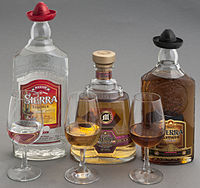
Photo from wikipedia
BACKGROUND Agaves are mainly used to produce alcoholic beverages such as tequila, mezcal, and bacanora. However, the leaves constitute more than 50% of the plant and are not used in… Click to show full abstract
BACKGROUND Agaves are mainly used to produce alcoholic beverages such as tequila, mezcal, and bacanora. However, the leaves constitute more than 50% of the plant and are not used in the production process, so they are considered waste. This plant material can be used as a source of bioactive compounds such as terpenes, flavonoids, and saponins. Therefore, the objective of this study was to characterize the aglycone type of saponins and to quantify the major sapogenins in leaves of five Agave species collected in different regions of Guerrero and Oaxaca. RESULTS Analysis by Gas Chromatography-Flame Ionization Detector (GC-FID) of the hydrolyzed methanolic extracts showed that diosgenin and tigogenin were the most abundant sapogenins identified in the five Agave species. Differences in the content of these sapogenins were found in the same species collected in different localities. The leaves of Agave americana var. oaxacensis L. (Oaxaca) had the highest diosgenin-derived saponins content, while the leaves of A. angustifolia Haw. (Guerrero) had the highest tigogenin-derived saponins content. Only in A. cupreata was sarsasapogenin identified, finding in the leaves of this species all three sapogenins. For the first time, information is provided on the aglycones of the saponins produced in A. potatorum Zucc. and A. karwinskii Zucc. CONCLUSION This study made it possible to compare the content of diosgenin and tigogenin saponins in leaves of Agave species from Guerrero and Oaxaca. This information will be useful for better utilization of this plant material and add value to the process of mezcal elaboration. This article is protected by copyright. All rights reserved.
Journal Title: Journal of the science of food and agriculture
Year Published: 2022
Link to full text (if available)
Share on Social Media: Sign Up to like & get
recommendations!